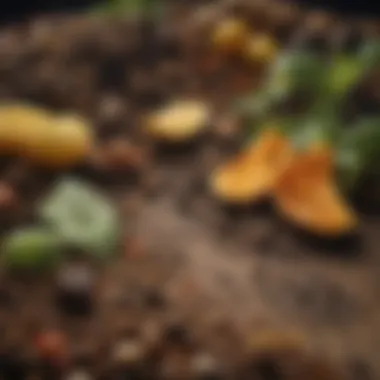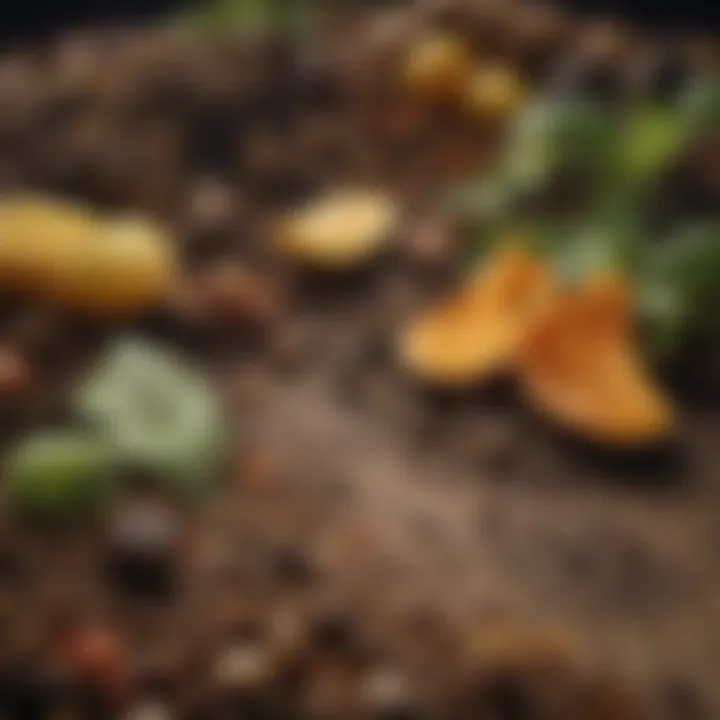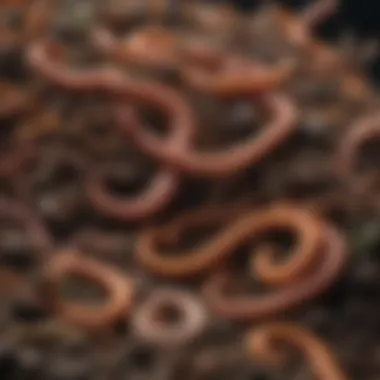Composting Information: A Comprehensive Guide


Intro
Composting represents a fundamental process in sustainable agriculture and effective waste management. By transforming organic matter into nutrient-rich soil, composting addresses multiple environmental concerns while providing practical benefits for farmers and gardeners alike. Understanding the basic principles of composting, as well as its evolution and emerging best practices, can empower individuals to make informed choices that foster ecological health.
This guide aims to delve into the intricate world of composting. It will highlight key concepts and terminology, recent innovations and trends, and practical applications and techniques that can enhance both personal and professional composting efforts. By the end of this article, readers will have gained a comprehensive grasp of how composting contributes to sustainability and how they can implement effective composting strategies in their own practices.
Prologue to Composting
Composting is a critical practice in modern agriculture and environmental management. The conversion of organic waste into nutrient-rich soil amendments not only reduces landfill use but also enhances soil health. Understanding composting's foundations is essential for anyone involved in sustainable agriculture, gardening, or waste management.
In this section, we focus on defining composting, its historical context, and its current significance. Each element offers insight into why composting is crucial for our ecosystems and agricultural practices today.
Defining Composting
Composting is the natural process of recycling organic matter, such as kitchen scraps and yard waste, into a valuable fertilizer. Through decomposition, microorganisms break down these materials, leading to a nutrient-rich product known as compost. This process can occur in various environments and forms, highlighting its flexibility in different settings. The key stages of composting include:
- Collection of organic materials
- Aerobic decomposition where oxygen is available
- Maturation, leading to a stable compost product
By understanding these phases, those involved in agriculture can capitalize on composting to enrich soil.
Historical Context
Composting is not a novel concept; its roots trace back for thousands of years. Early civilizations, including the Egyptians and Romans, recognized the benefits of organic recycling. They used composted remains to enhance soil fertility. Over time, techniques evolved, shaped by regional practices and available materials.
In the 20th century, as industrial agriculture surged, the shift towards synthetic fertilizers overshadowed traditional composting. However, with rising environmental concerns, interest in composting has resurged. People are now revisiting these age-old methods to improve their environmental impact and bolster sustainable agriculture.
Importance of Composting
The importance of composting cannot be overstated. It contributes to:
- Soil Health: Improving soil structure, fertility, and moisture retention.
- Waste Reduction: Diverting organic waste from landfills, curbing methane emissions.
- Nutrient Cycling: Returning essential nutrients back to the soil ecosystem.
"Composting is more than recycling. It's about creating a closed-loop system that benefits the environment."
These factors make composting a vital practice. For farmers and gardening enthusiasts, the insights from this introduction lay the groundwork for adopting effective composting practices that yield tangible benefits.
The Science of Composting
Understanding the science behind composting is crucial for anyone looking to improve their gardening or agricultural practices. Composting is not just a method of waste reduction; it is also a dynamic process that transforms organic materials into nutrient-rich compost. By studying the biological and chemical processes involved, one can optimize this practice, ensuring effective decomposition. This section will delve into the key aspects of biological decomposition, the role of microorganisms, and the various factors that influence the efficiency of composting.
Biological Decomposition
Biological decomposition is the process by which organic matter breaks down due to the action of living organisms. This stage is fundamental for the transition of waste into compost. Microorganisms, including bacteria and fungi, play a pivotal role here. They secrete enzymes that break down complex organic compounds into simpler substances, allowing for nutrient availability. In addition to microorganisms, larger organisms like earthworms and insects contribute to the breakdown process, aiding in aeration and mixing.
The process can be divided into stages: initial breakdown, where bacteria initiate decomposition, followed by stabilization, where fungi take a leading role. Effective biological decomposition leads to increased nutrient content in the final compost product.
Microorganisms Involved
Microorganisms are the unsung heroes in composting. Bacteria are the first responders, rapidly consuming organic matter. Different types of bacteria thrive at various temperatures. Mesophilic bacteria, for example, operate at moderate temperatures, whereas thermophilic bacteria prefer higher levels. Then, fungi come into play, especially in later stages, breaking down more complex organic materials such as cellulose and lignin found in dead plant matter.
The balance between these microorganisms influences the composting process. A diverse microbial community can lead to faster decomposition and a better-quality end product. It is essential to maintain conditions that foster these microorganisms, ensuring that the composting system remains active and efficient.
Factors Influencing Decomposition
Decomposition is not a static process; it is influenced by various environmental factors. Understanding these factors helps to manage composting effectively.
Temperature
Temperature plays a critical role in the decomposition process. Higher temperatures generally accelerate microbial activity, promoting faster breakdown of materials. Temperatures around 130°F to 160°F are optimal for thermophilic bacteria, which significantly enhance the decomposition rate. However, if temperatures get too high, it can kill beneficial microorganisms, hindering composting.
Key characteristics of temperature include its direct relationship with microbial activity and its influence on the speed of decomposition. Maintaining an appropriate temperature can vastly improve composting efficiency, making it a popular choice for advanced composting techniques.
Moisture
Moisture is essential for microorganisms to thrive. A compost pile should maintain a moisture level similar to that of a damp sponge. Too little moisture can slow down decomposition, leading to a lack of microbial activity. Conversely, excess moisture can create anaerobic conditions, resulting in unpleasant odors and potentially attracting pests.
The unique feature of moisture is its ability to facilitate the movement of nutrients; it helps dissolve nutrients for microorganisms to assimilate. The balance of moisture is fundamental for creating a healthy compost system.
Oxygen Levels
Oxygen levels are another pivotal factor in the composting process. Aerobic decomposition, which occurs in the presence of oxygen, leads to faster and more efficient composting. Adequate aeration prevents the buildup of anaerobic bacteria, which can cause foul odors. Regularly turning the compost pile introduces air, maintaining optimal oxygen levels.
The key characteristic of oxygen is its role in supporting aerobic microorganisms, which are essential for producing heat and breaking down organic matter quickly. Proper management of oxygen levels encourages a thriving compost ecosystem.
Carbon to Nitrogen Ratio
The carbon to nitrogen ratio (C:N) is critical for composting success. A balanced ratio, typically between 25:1 and 30:1, ensures ideal microbial growth. Carbon provides energy, while nitrogen is essential for protein synthesis in microorganisms. Too much carbon can lead to slow decomposition, while excess nitrogen can create odor issues.
The unique feature of C:N ratio is its significant impact on the speed and quality of composting. Monitoring and adjusting this ratio can enhance the efficiency of the composting process, making it a fundamental concept for successful composting.
Overall, understanding the science of composting provides both insight and practical knowledge. This knowledge allows emerging composting practices to be more efficient and sustainable.
Types of Composting


Understanding the different types of composting is essential for maximizing the efficiency and effectiveness of composting efforts. Each method offers unique benefits and considerations, catering to varying needs based on space, materials, and overall goals. Selecting the appropriate type of composting can lead to faster decomposition, better results in garden health, and a worthwhile contribution to sustainable practices.
Hot Composting
Hot composting is an active process that relies on thermophilic decomposition. This method involves creating a pile of compost materials that generates significant heat, reaching temperatures between 130°F to 160°F. The primary advantage of hot composting is its speed. If executed correctly, it can transform organic waste into usable compost in as little as three weeks.
To achieve hot composting, the following factors are crucial:
- Proper Layering: Alternate layers of green materials (high in nitrogen) and brown materials (high in carbon).
- Adequate Size: The compost pile should be at least three feet wide and three feet tall to facilitate heat production.
- Regular Turning: Turning the pile helps to aerate it, promoting oxygen flow and maintaining high temperatures.
Properly maintained hot compost not only decomposes quickly but also helps kill off pathogens and seeds, making it an efficient method for those who seek rapid results.
Cold Composting
Cold composting is a more passive approach that requires less maintenance and effort. This method involves piling up materials and letting them decompose naturally over time without the intervention of turning or frequent monitoring. Cold composting can take several months to years to produce finished compost.
While it is slower, cold composting has its advantages:
- Simplicity: There is no need for regular turning or monitoring temperature.
- Diversity of Materials: Almost any organic waste can be added, from kitchen scraps to yard debris, without concern for balance.
- Cost-Effectiveness: It doesn’t require special equipment or techniques, making it accessible to anyone.
Despite the lengthy process, cold composting is still a viable option for those who prefer a low-maintenance method while contributing to waste reduction.
Vermicomposting
Vermicomposting is an innovative method that utilizes earthworms, particularly red wigglers, to expedite the composting process. It’s especially suitable for limited spaces, such as apartments or small backyards. The worms break down organic matter and produce nutrient-rich castings, known as worm compost.
Some essential points about vermicomposting include:
- Minimal Space Requirement: A small bin can accommodate it, making it ideal for urban gardeners.
- Quick Processing: Worms can consume their body weight in food daily, producing compost faster than traditional methods.
- Balanced Nutrients: Worm compost often contains beneficial microbes and nutrients, enhancing soil fertility.
However, it requires proper management, including maintaining moisture levels and avoiding certain materials that can harm the worms.
Bokashi Composting
Bokashi composting is a unique fermentation method that utilizes specific microorganisms to break down organic waste. This technique can handle meat, dairy, and other materials not suitable for traditional composting.
Key aspects of Bokashi composting include:
- Anaerobic Process: Waste is placed in an airtight container with Bokashi bran, a mixture of wheat bran and effective microorganisms, allowing it to ferment.
- Speedy Fermentation: The process typically takes about two weeks before the material can be buried in soil to complete the decomposition.
- Odor Control: The airtight conditions minimize unpleasant smells, making it suitable for indoor use.
Bokashi composting aligns well with those looking to compost a broader range of materials without the restrictions of traditional methods.
Materials for Composting
The choice of materials is crucial in the composting process. The right balance of materials can determine the efficiency of decomposition and the quality of the final compost product. Composting materials are generally classified into green and brown categories, each playing a distinctive role in the composting process. Understanding these materials can help anyone interested in composting to create nutrient-rich compost that is beneficial for planting.
Green Materials
Green materials are the nitrogen-rich components of compost. They include perishable items such as kitchen scraps, grass clippings, and fresh plant matter. These materials contribute essential nitrogen, which promotes microbial activity in the compost pile. Higher microbial activity accelerates decomposition, which is essential for producing quality compost.
Common examples of green materials are:
- Fruit and vegetable scraps
- Coffee grounds
- Grass clippings
- Plant trimmings
Incorporating a good mix of green materials can help maintain moisture in the compost system. However, too much nitrogen can lead to a smelly pile. It is important to monitor the proportion of green materials to achieve optimal results.
Brown Materials
Brown materials are rich in carbon and provide structural integrity to the compost pile. They help aerate the compost, preventing compaction and creating pockets of air that are vital for aerobic decomposition. Typical browns include dried leaves, straw, and cardboard. These materials need to be included in a compost pile in a specific ratio, often three times more brown than green.
Some suitable brown materials consist of:
- Dried leaves
- Twigs and branches
- Shredded paper
- Hay or straw
Balancing brown materials with green is essential. If there are insufficient brown materials, the compost can turn anaerobic, resulting in unpleasant odors and pests. The key is to layer these materials thoughtfully to ensure optimal moisture and aeration throughout the composting process.
Avoiding Contaminants
Not every material is suitable for composting. Being mindful of contaminants is necessary to avoid compromising the quality of compost. Some materials can introduce pathogens, toxins, or pests that can harm plants or the environment. Understanding what to avoid can help you maintain a healthy compost composition.
Common contaminants to avoid:
- Meat and dairy products (these attract pests)
- Oily foods (these can slow down decomposition)
- Pet waste (may contain pathogens)
- Weeds that are mature (they can regrow)
"Maintaining a clean composition is essential for achieving high-quality compost."
Sticking to the right materials will not only produce effective compost but also ensure the overall health of your composting system. By selecting quality green and brown materials, while avoiding contaminants, you can create a thriving compost ecosystem that benefits your garden and the environment.
Composting Techniques
Composting techniques play a crucial role in converting organic waste into nutrient-rich compost. Understanding these methods allows individuals to optimize their composting process, improve soil health, and contribute to environmental sustainability. By applying effective techniques, one can enhance the decomposition rate, reduce bad odors, and deter pests. Each method has specific benefits and considerations, making it essential to choose the most suitable approach based on individual requirements, available space, and the type of materials being composted.
Layering Method


The layering method of composting involves strategically placing different types of materials in layers within the compost pile or bin. This approach is important as it promotes optimal aeration and balances the essential components needed for effective decomposition. The layers typically include alternates of green materials, such as fruit scraps and grass clippings, and brown materials like dried leaves and cardboard.
- Benefits: This method helps in creating an aerobic environment. The separation of materials allows for better airflow, facilitating faster decomposition.
- Considerations: It is crucial to maintain the right carbon to nitrogen ratio, ideally between 25:1 and 30:1. If the layers are too dense, it can lead to anaerobic conditions, resulting in foul odors.
Turning and Aeration
Turning and aeration are vital practices in composting, influencing the breakdown process of the materials. Aeration allows oxygen to reach the microorganisms, which are essential for decomposition. By periodically turning the compost pile, one enhances airflow and prevents compaction.
- Benefits: Regular turning of the compost helps maintain consistent temperatures. Higher temperatures encourage the growth of thermophilic microorganisms, speeding up the decomposition process.
- Considerations: It is recommended to turn the pile every few weeks. Overdoing it can disrupt the growth of beneficial microbes, while not doing it enough can lead to a compact and slower composting process.
Monitoring Compost Health
Monitoring compost health is essential to ensure that the materials are decomposing efficiently. Regular observation allows for timely adjustments, addressing potential issues before they escalate.
- Key Indicators:
- Temperature: A well-maintained compost pile should generate heat, indicating active microbial activity. High temperatures (between 130°F and 160°F) are optimal for pathogen reduction and accelerated decomposition.
- Moisture Level: Compost should remain moist but not soggy. If it's too dry, decomposition slows down. Conversely, excess moisture can lead to anaerobic conditions.
- Odor: A healthy compost pile should emit an earthy smell. Strong, unpleasant odors indicate possible issues such as over-wet conditions or an imbalance in materials.
"Monitoring these indicators ensures the composting process remains on track, enabling successful compost production."
By employing effective layering methods, adequate aeration practices, and consistent monitoring, composting can be a fruitful endeavor, contributing to a sustainable agricultural ecosystem.
Troubleshooting Common Issues
In any composting endeavor, encountering problems is inevitable. Understanding these common issues is crucial for success. Being aware of potential hurdles enables individuals to maintain a healthy compost system. It empowers them to quickly respond to any arising challenges. This section will address three frequent issues: bad odors, pests and rodents, as well as slow decomposition.
Bad Odors
Bad odors are perhaps the most immediate and alarming sign of a compost issue. A well-functioning compost pile should have earthy, pleasant smells. If it stinks, it often indicates an imbalance in the composting materials. There are a few main causes for bad scents, typically linked to excess moisture, an overabundance of green materials, or insufficient aeration.
When moisture levels are too high, the compost can become anaerobic, leading to foul smells. To fix this, consider adding more brown materials like dry leaves or shredded paper to absorb excess moisture. If the compost pile is wet but lacks proper aeration, turning the pile can help. Turning it every couple of weeks introduces oxygen, which aids the decomposition process and reduces odors.
Pests and Rodents
Another common issue involves pests and rodents. While some insects are beneficial for composting, others can work against it. Rodents are often attracted to compost because of the organic materials it contains. To minimize the risk of infestations, cover the compost pile with a layer of brown materials. This practice helps deter rodents by making the food source less accessible.
It is also vital to avoid adding meat, dairy, or oily foods to the compost. These items can draw unwanted visitors. Using a closed compost bin can further prevent pests from accessing the materials inside. Monitoring the compost regularly can aid in identifying and addressing infestations early.
Slow Decomposition
Slow decomposition can be frustrating for many composters. It indicates that the materials are not breaking down as quickly as expected. Several factors can contribute to this problem, including the carbon to nitrogen ratio, particle size, and moisture levels.
A proper carbon to nitrogen ratio is essential for decomposition. Ideally, compost should maintain a balance between browns (high in carbon) and greens (high in nitrogen). The ideal ratio is often cited as 30:1. If the carbon content is too high, decomposition will slow down. Similarly, overly large pieces of material can hinder breakdown. Shredding or chopping materials can facilitate quicker decomposition.
Furthermore, if moisture levels drop too low, the composting process may stall. Regularly checking moisture levels is essential. If the pile feels dry, it's time to add water. Striking a balance between all these factors will lead to a more effective composting process.
Using Finished Compost
Using finished compost is a pivotal component in the overall composting ecosystem. It translates the painstaking efforts of composting into tangible benefits for soil health and plant growth. Once the compost reaches a mature state, its potential becomes evident in various agricultural and gardening practices. The benefits extend beyond mere nutrient addition; they involve improving soil structure, enhancing water retention, and fostering soil biodiversity.
Soil Amendment
Soil amendment is one of the key uses of finished compost. Applying compost to soil enriches it with essential nutrients like nitrogen, phosphorus, and potassium. These are crucial for plant growth and development. Compost also contributes organic matter, which improves soil texture. This is particularly significant for sandy soils, which often lack nutrient-holding capacity. Stronger soil integrity fosters healthier root systems and promotes better overall plant health.
Key Details:
- Nutrient Boost: Provides a measured release of nutrients to plants.
- Improved Structure: Enhances clay and sandy soil, aiding in aeration and drainage.
- Microbial Activity: Increases beneficial microorganisms which support plant growth.
Utilization of finished compost as a soil amendment not only supports immediate plant health but also contributes to long-term soil fertility and sustainability.
Mulching
Another significant application of finished compost is mulching. As a natural mulch, compost provides several advantages that are especially useful in gardening and landscaping. When spread over the soil surface, compost helps retain moisture, suppress weeds, and regulate soil temperature. This is particularly important in dry conditions, as it helps maintain optimal moisture levels for plant roots. Moreover, as the compost breaks down over time, it continues to feed the soil, promoting ongoing nutrient cycling.
Benefits of Mulching with Compost:
- Moisture Retention: Reduces evaporation, keeping the soil hydrated.
- Weed Control: Deters weed growth by blocking light.
- Temperature Regulation: Keeps soil temperatures stable during temperature fluctuations.
Using finished compost in the form of mulch not only emphasizes sustainable practices but also enhances the overall aesthetics of garden spaces.
Composting in Gardening Practices
Incorporating finished compost into gardening practices symbolizes a strong commitment to sustainable gardening. Many gardeners find that mixing matured compost into their planting beds can significantly improve yield and plant vibrancy. Besides acting as a nutrient source, it also encourages a healthy ecosystem in the garden. Plants benefit notably from compost's ability to enhance soil structure through aeration and increase microbial diversity, which can ward off diseases.
Strategies for Successful Utilization:
- Mixing In: Blend compost into the top few inches of soil prior to planting.
- Top Dressing: Add a layer of compost on top of existing vegetation to boost nutrients.
- Compost Tea: Infuse nutrients more rapidly by soaking compost in water to create a nutrient-rich “tea” for watering plants.
Overall, employing finished compost in gardening not only reuses organic waste but also leads to thriving, resilient garden ecosystems. By understanding these aspects of finished compost, gardeners can make informed, impactful choices that enhance both plant and soil health.
Composting and Sustainability
Composting plays a critical role in sustainability efforts by transforming organic waste into valuable resources. Its significance emerges from the urgent need to address waste management and environmental preservation. This section delves into the specific elements that underscore the connection between composting and sustainable practices, enabling a comprehensive understanding of their broader impact on ecological balance and resource management.


Environmental Benefits
Composting is not just a method for disposing of organic materials; it serves as a vital component in enhancing ecological health. Some key benefits include:
- Reduction in Greenhouse Gas Emissions: When organic waste decomposes in landfills, it generates methane, a potent greenhouse gas. Composting minimizes this emission by promoting aerobic decomposition.
- Habitat Creation: Finished compost enriches soil, fostering diverse plant growth. Healthy ecosystems support wildlife, thus promoting biodiversity.
- Water Conservation: Compost improves soil structure, enhancing its ability to retain moisture. This quality reduces the need for frequent irrigation, a key consideration in water-scarce regions.
- Pollution Reduction: Composting diverts waste from landfills, leading to lower pollution levels associated with landfill operations, such as leachate and air emissions.
"Composting not only aids in waste management but also positively impacts the environment, fostering sustainable practices that benefit all living beings."
Impact on Soil Health
The health of soil is crucial to agriculture and overall ecosystem functionality. Composting directly contributes to soil quality in several ways:
- Nutrient-Rich Additive: Compost provides essential nutrients to the soil, including nitrogen, phosphorus, and potassium. This nutrient boost supports plant growth and increases crop yields.
- Soil Structure Improvement: Compost enhances soil texture, promoting better aeration and drainage. This improvement allows roots to access nutrients and water more effectively.
- Microbial Activity Promotion: Composting introduces beneficial microorganisms into the soil. These microbes play a role in breaking down organic matter further, aiding nutrient cycling and improving soil health over time.
- pH Balance: Compost can help neutralize acidic or alkaline soils, creating a more hospitable environment for various plant species.
Reducing Waste in Landfills
The increase in global population has led to an alarming rise in waste generation. Composting serves as an effective strategy to combat this growing issue:
- Waste Diversion: Composting facilitates the diversion of organic material from landfills. This action not only lowers waste volume but also maximizes landfill lifespan.
- Economic Savings: Reduced waste in landfills translates to lower disposal fees for municipalities. This economic incentive encourages more communities to adopt composting practices.
- Community Engagement: Many composting initiatives promote local involvement. As individuals participate, awareness increases regarding waste reduction and sustainable practices.
Composting Regulations and Standards
Composting regulations and standards play a crucial role in ensuring that composting practices are safe, effective, and environmentally friendly. As the demand for sustainable waste management increases, understanding these regulations is vital for gardeners, farmers, and communities involved in composting. These rules not only guide the process but also protect public health and the environment.
The significance of compliance with composting regulations cannot be overstated. They help prevent contamination of the compost, which can lead to soil and water pollution. Furthermore, adhering to these standards fosters public trust in composting practices, encouraging wider community participation.
Local Regulations
Local regulations surrounding composting can differ widely, reflecting each community's specific needs and environmental concerns. In many places, local authorities set guidelines to govern everything from the types of materials allowed in compost piles to the management of odors and pests. Understanding these local laws is essential for anyone looking to start a composting program.
Key aspects of local regulations may include:
- Material Restrictions: Some locations might restrict certain materials, like meat or dairy, due to health concerns.
- Compost Size Limits: There may be restrictions on the size and scale of compost heaps to mitigate odors and other issues.
- Permitting Requirements: Certain municipalities may require permits for larger composting operations.
Navigating these regulations can be challenging but is essential for ensuring compliance and promoting successful composting efforts.
Permits and Guidelines
Permits and guidelines are often a necessity for formal composting operations, particularly those that plan to produce large quantities of compost. These documents typically outline essential practices that operators must follow to ensure safety and compliance with local laws.
Considerations that may require guidelines or permits include:
- Scale of Operation: Larger operations may differ significantly in terms of management and permitting compared to backyard composting.
- Health and Safety Regulations: These regulations often involve ensuring that compost does not attract pests or create unsanitary conditions.
- Environmental Impact Assessments: Some regulations may mandate assessments to evaluate how composting activities could affect local ecosystems.
Obtaining the correct permits can seem daunting, but it is an important step toward responsible composting. Proper documentation helps maintain accountability and transparency, while also aligning with broader sustainability goals.
"Composting regulations are in place to help ensure effective composting that benefits both people and the planet."
Innovations in Composting Technology
The advancement in composting technology plays a crucial role in enhancing efficiency and effectiveness of composting practices. These innovations not only offer convenience but also contribute to environmental sustainability. Understanding these technologies helps agricultural operators and gardening enthusiasts explore more effective options for transforming organic waste into useful compost.
Composting Machines
Composting machines are a notable development in the composting realm. These devices automate the process of composting, making it more manageable for users. They often feature mechanisms that can grind, mix, and aerate compost materials rapidly.
The main benefit of using composting machines is the reduction in time. Traditional composting can take months to yield finished product; machines can shorten the process to weeks or even days. Some machines control temperature and moisture levels, optimizing decomposition conditions without much human intervention. Popular options include the NatureMill Indoor Composting Bin and the FoodCycler, which cater to household waste and urban gardening needs. Utilizing these machines simplifies composting for individuals who may lack the time or space for traditional methods.
Moreover, these machines often come equipped with features like odor control and pest prevention, further making them ideal for urban environments. Their compact designs suit apartments and small homes, where outdoor space for composting is limited.
Community Composting Initiatives
Community composting initiatives are another innovation gaining traction. These programs encourage neighborhoods to come together to recycle organic waste collectively into compost. Such initiatives often create centralized composting sites, allowing larger quantities of organic waste to be processed efficiently.
Participation in community composting has several benefits:
- Social Cohesion: It fosters community spirit as individuals collaborate toward a common goal.
- Education: These programs often provide workshops on composting, informing participants about best practices.
- Waste Reduction: By bundling resources, communities can significantly reduce the organic waste sent to landfills.
- Soil Quality Improvement: The compost produced supports local agricultural efforts, enhancing soil health.
Cities like San Francisco and Seattle have pioneered community composting, effectively demonstrating how collective approaches can lead to sustainable waste management. Websites like reddit.com showcase community discussions on how to implement such programs.
"Community composting not only benefits the environment, but it also builds relationships among local members."
Epilogue
The conclusion of this article holds significant value, encapsulating the essence of composting and its many facets. First, it serves as a recap that reinforces the substantial points covered across all sections, allowing readers to synthesize the information effectively. Composting is not merely a practice for gardeners; it is an essential method for sustainable waste management that contributes positively to soil health and environmental stewardship.
Recap of Key Points
- Definition and Importance: Composting is the natural process of recycling organic material, such as food scraps and yard waste, into a valuable fertilizer rich in nutrients. It plays a pivotal role in reducing waste and enriching soil.
- Science Behind Decomposition: The article delves into the biological processes involved in composting, such as the role of microorganisms and environmental factors that influence decomposition, which are crucial for effective composting.
- Types and Techniques: Various composting methods, including hot composting and vermicomposting, have been discussed. Each method has its own benefits and considerations, appealing to different needs and spaces.
- Materials and Methods: Understanding what materials are suitable for composting and the best techniques for maintaining optimal conditions is vital to success. This includes the right balance of green and brown materials, aeration, and moisture management.
- Applications and Sustainability: The practical uses of finished compost, including soil amendment and mulching, highlight its value in sustainable gardening and agriculture. Composting contributes to soil health, promotes biodiversity, and reduces landfill contributions, making it a cornerstone of ecological practices.
"Composting transforms waste into treasure, enhancing soil and reducing waste alike."
Future of Composting Practices
Looking ahead, the future of composting practices will likely evolve with trends in sustainability and technology. The integration of smart technology in composting systems might streamline processes, offering more efficient methods of waste management.
- Emerging Technologies: Innovations like composting machines could simplify the process for urban dwellers with limited space. Community composting initiatives can also gain traction, promoting local engagement and awareness about sustainable practices.
- Policy and Support: With growing emphasis on environmental policies, governments may implement more regulations and support for composting efforts, making it easier for individuals and communities to participate.
- Education and Awareness: More educational resources and programs can empower individuals to adopt composting successfully, fostering a culture that values sustainability.
In summary, the importance of composting only intensifies as we face environmental challenges. Its multifaceted benefits extend beyond the garden, contributing to a holistic approach to sustainability. Readers are encouraged to take the insights gained from this guide and incorporate them into their practices, thus promoting a more sustainable future.















